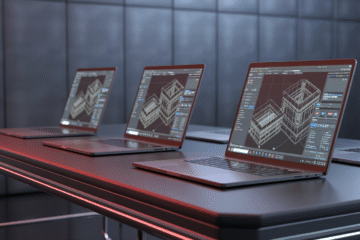Top 6 Best 14-Inch Laptops (2025)
A great 14-inch laptop is the sweet spot between portability and productivity: big enough for spreadsheets and split-screen multitasking, small enough to disappear in a backpack. In 2025, the best models combine efficient processors, bright 16:10 displays, strong battery life, and thoughtful I/O (USB-C/USB4 plus at least one legacy USB-A). This guide explains what to look for, then ranks the Top 6 Best 14-inch laptops from 6 to 1 exactly as requested:
-
-
Lenovo IdeaPad Slim 3i Laptop See on Amazon
-
-
-
ASUS Vivobook Laptop See on Amazon
-
-
-
Dell Inspiron 14 5440 Laptop See on Amazon
-
-
-
HP TPN-Q221 Laptop See on Amazon
-
-
-
Lenovo ThinkPad T14 Laptop See on Amazon
-
-
-
Dell Latitude 5450 Laptop See on Amazon
-
How to Choose a 14-Inch Laptop in 2025
Display & Comfort (What You Stare At All Day)
-
Size & Ratio: 14″ with 16:10 shows more vertical lines (fewer scrolls in docs and code).
-
Panel: IPS or OLED; aim for 300–400 nits and solid color coverage for presentations and light creative work.
-
Finish: Anti-glare (matte) helps in bright rooms; glossy looks punchier but reflects.
Performance That Stays Fast
-
CPU: Look for the latest Intel Core Ultra or AMD Ryzen 7000/8000-class chips; prioritize a balance of single-core snappiness (UI, office apps) and multi-core headroom (compiles, exports).
-
RAM: 16GB is the real-world baseline; 32GB for heavy multitasking or dev tools.
-
Storage: 512GB NVMe minimum; 1TB if you keep local media or large datasets.
Battery, Ports & Connectivity
-
Battery life: Expect a full workday (8–12 hours) under mixed use with 200–250 nits brightness.
-
Ports: USB-C (with PD charging) + USB-A for legacy peripherals + HDMI for conference rooms. USB4/Thunderbolt is a plus for docks and fast SSDs.
-
Wireless: Wi-Fi 6/6E and BT 5.x are table stakes.
Build, Keyboard, and Serviceability
-
Chassis: Aluminum or reinforced composite for stiffness; look for MIL-style durability on business lines.
-
Input: A consistent keyboard and large glass touchpad make a difference in long sessions.
-
Upgrades: SODIMM RAM and dual NVMe slots are rare but valuable; at minimum, a user-replaceable SSD is nice.
6- Lenovo IdeaPad Slim 3i Laptop
Who It’s For
Students, first-time buyers, and everyday users who value a clean, lightweight 14-inch machine at a friendly price.
Why It Stands Out
The IdeaPad Slim 3i keeps essentials front and center: an efficient processor, a comfortable keyboard, and a bright enough display for classrooms and cafés. It’s the kind of laptop that doesn’t get in your way while you learn, write, and research.
What to Prioritize
-
RAM: Choose 16GB for smooth multitasking (browser tabs + docs + calls).
-
Storage: 512GB NVMe for apps and class projects.
-
Display: IPS panel if available; 300-nit options are worth it.
Everyday Experience
Boots quickly, handles slides and reports, and sails through meetings on Teams/Meet. The battery comfortably lasts a school day at moderate brightness.
Strengths
-
Affordable entry with the right compromises
-
Comfortable typing and a reliable trackpad
-
Solid battery for its weight class
Trade-Offs
-
Plastics feel less premium than pricier peers
-
Speakers/webcam are serviceable rather than stellar
5- ASUS Vivobook Laptop
Who It’s For
Learners, freelancers, and light creators who want strong day-to-day performance and a nicer screen option without jumping to a premium flagship.
Why It Stands Out
The Vivobook family often punches above its price with bright, color-friendly panels, modern CPUs, and practical I/O. Many SKUs balance battery life and speed well for a 14″.
What to Prioritize
-
Display: Look for 16:10 IPS or OLED, 300+ nits.
-
Memory/Storage: 16GB / 512GB minimum; 1TB if you store media locally.
-
Ports: Prefer SKUs with USB-C PD charging plus HDMI and USB-A.
Everyday Experience
Feels quick in Chrome/Edge, Office, and basic Lightroom/Canva tasks; fans stay civil in balanced profiles. A good middle lane for students who moonlight as creators.
Strengths
-
Attractive screens for the money
-
Solid typing feel; decent webcam/mics
-
Good balance of portability and punch
Trade-Offs
-
Thermals under sustained loads can warm
-
Feature set varies by region/SKU; check specs carefully
4- Dell Inspiron 14 5440 Laptop
Who It’s For
Hybrid professionals and students who want a dependable 14″ that’s easy to service, easy to live with, and ready for docked desk setups.
Why It Stands Out
The Inspiron 14 5440 is Dell’s sensible middle ground: modern processors, a crisp 14″ display, and meeting-friendly ports (USB-C, USB-A, HDMI). It’s built for people who run multiple apps simultaneously and frequently move between home and campus/office.
What to Prioritize
-
RAM: 16GB baseline; 32GB if you keep Slack/Teams + heavy spreadsheets open.
-
Storage: 1TB NVMe to avoid space anxiety.
-
Wireless: Wi-Fi 6/6E for crowded networks.
Everyday Experience
Boots cleanly, runs quietly in balanced mode, and happily drives an external 1440p/4K monitor through a USB-C dock. Exactly the kind of laptop that feels invisible in a good way.
Strengths
-
Thoughtful I/O (bye-bye, dongle drama)
-
Comfortable keyboard and large touchpad
-
Good thermals for long meetings and multitasking
Trade-Offs
-
Not as rugged as business lines
-
Speakers and webcam are fine, not flagship-grade
3- HP TPN-Q221 Laptop
Who It’s For
Professionals and students who want premium-leaning portability: a slim chassis, long battery life, and a refined 14″ experience that still keeps performance steady.
Why It Stands Out
Under HP’s internal code TPN-Q221, this 14″ platform focuses on efficiency and polishing a bright screen, quiet fans, and power profiles that make it easy to get through a day of calls and documents.
What to Prioritize
-
Display: Aim for 300–400 nits IPS and 16:10 if offered.
-
RAM/Storage: 16GB / 512GB (1TB if you keep media or datasets local).
-
Charging: A compact 65W USB-C PD charger keeps the whole kit light.
Everyday Experience
Snappy for office work, research, and light creative tasks; touchpad gestures feel smooth, and the webcam with noise-reduced mics is dependable for frequent meetings.
Strengths
-
Strong battery for a thin 14″
-
Quiet operation; travel-friendly build
-
Clean HP software profiles (not overloaded)
Trade-Offs
-
Port layout can be compact for some SKUs
-
For heavy GPU/creator work, look to a higher tier
2- Lenovo ThinkPad T14 Laptop
Who It’s For
Knowledge workers, consultants, and developers who want a durable 14″ with the best typing feel, top-tier manageability, and real-world reliability.
Why It Stands Out
The ThinkPad T14 is a classic for a reason: MIL-style durability, a legendary keyboard, TrackPoint/precision touchpad combo, and enterprise-ready security and manageability. It’s the 14″ you buy when you need to trust your machine.
What to Prioritize
-
CPU: Latest Intel Core or AMD Ryzen with efficient integrated graphics (or optional dGPU where offered).
-
RAM/Storage: 16–32GB, 1TB NVMe.
-
Display: 16:10 IPS 300–400 nits; ePrivacy or low-power panels available on some configs.
Everyday Experience
Typing marathons are comfortable, the hinge is confidence-inspiring, and the chassis shrugs off travel. Docking via USB4/Thunderbolt is seamless, and the system remains stable under heavy multitasking.
Strengths
-
Industry-leading keyboard and business ergonomics
-
Rugged build, easy IT enrollment, and servicing
-
Excellent port selection for a 14″
Trade-Offs
-
Heavier than ultra-slim consumer models
-
Premium configs can get pricey
1- Dell Latitude 5450 Laptop
Who It’s For
Teams, executives, and power users who want the most balanced 14″ business laptop in 2025: robust security, great battery, superb input devices, and fleet-friendly reliability all in a compact chassis.
Why It Stands Out
The Latitude 5450 delivers what business travelers and serious students need day in, day out: long real-world battery, quiet thermals, fast wake, and meeting-proof ports. It’s also built for organizations that care about manageability, BIOS controls, and quick support.
What to Prioritize
-
CPU: Modern Intel Core Ultra for efficiency and responsive performance.
-
RAM/Storage: 16–32GB, 1TB NVMe (plus a second SSD if your SKU supports it).
-
Display: 14″ 16:10, 300-400 nits, low-blue options if you’re screen-bound.
Everyday Experience
From airport lounges to conference rooms, the 5450 feels calm and capable: stable on calls, snappy with documents and dashboards, and unfussy with docks and projectors. It’s the 14″ that just keeps you moving.
Strengths
-
All-day battery with efficient panel options
-
Excellent keyboard/trackpad for long work sessions
-
Broad, practical I/O and enterprise features
Trade-Offs
-
Not a creator/gaming rig (by design)
-
Upgrades vary by configuration; check before you buy
Quick Picks by Scenario
Best Budget Student Pick
Lenovo IdeaPad Slim 3i – Affordable, light, and perfectly matched to schoolwork with 16GB RAM.
Best Value for Light Creators
ASUS Vivobook (14″) -Better-than-expected display options and smooth day-to-day speed.
Best Hybrid Worker
Dell Inspiron 14 5440 – Practical ports and thermals for docked or mobile days.
Best Thin-and-Quiet Traveler
HP TPN-Q221 – Sleek, quiet, and stamina to spare.
Best Typing & Durability
Lenovo ThinkPad T14 – The king of keyboards and business toughness.
Best Overall Business 14″
Dell Latitude 5450 – Balanced battery, portability, and enterprise polish.
Configuration Cheatsheet (Copy This)
Minimums You Won’t Regret
-
CPU: Latest Intel/AMD
-
RAM: 16GB
-
Storage: 512GB NVMe
-
Display: 14″, 16:10, ≥300 nits
-
Ports: USB-C PD + USB-A + HDMI
-
Wireless: Wi-Fi 6/6E
Upgrades That Matter
-
32GB RAM for dev tools, VMs, or heavy multitasking
-
1TB NVMe for local media and large datasets
-
Dock + 27″ monitor to turn a 14″ into a desktop setup at home/office
Battery & Performance Tips
Get Real All-Day Endurance
-
Keep brightness at 200–250 nits indoors.
-
Use battery saver/low power during writing or reading.
-
Close background updaters you don’t need; prune heavy extensions.
Keep It Fast
-
Leave 20–25% free SSD headroom; systems run better with space.
-
Update BIOS/firmware for fan curves and stability improvements.
-
Use a cooling stand for long video calls or compilations.
Frequently Asked Questions
Is 8GB RAM enough in 2025?
Only for light use. 16GB keeps browsers, calls, and office apps smooth; 32GB if you run dev stacks, VMs, or do heavy multitasking.
Do I need Thunderbolt/USB4?
Not mandatory, but very convenient for single-cable docks and fast external SSDs. If you plan a desk setup, it’s worth prioritizing.
IPS or OLED?
IPS is great for anti-glare office use. OLED looks fantastic for content, but be mindful of reflections and choose models with good anti-burn-in management.
Can a 14″ replace my desktop?
Yes pair it with a USB-C/USB4 dock and 27″ 1440p/4K monitor, keyboard, and mouse. You’ll enjoy desktop ergonomics with laptop mobility.
Final Verdict
If you want the most balanced, no-drama 14″ in 2025, the Dell Latitude 5450 leads: excellent battery, refined inputs, practical ports, and enterprise reliability. For typing feel and ruggedness, the Lenovo ThinkPad T14 is still the gold standard. Travelers who value thin-and-quiet stamina will love HP’s TPN-Q221. The Dell Inspiron 14 5440 is a practical hybrid workhorse, while the ASUS Vivobook delivers creator-friendly value. On a strict budget, the Lenovo IdeaPad Slim 3i covers the essentials with room to grow.



0 Comments